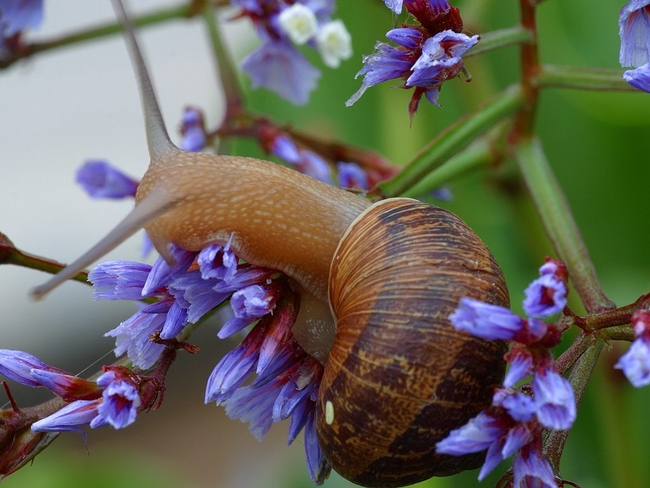By the UC Master Gardener Program of Fresno County
- Prepared by: Terry Lewis
Published on: May 10, 2024
The garden is in full bloom. Cut flowers and harvest produce frequently to encourage repeated production of flowers and veggies. Pull weeds and hoe often. Trap snails and slugs beneath boards or flower pots. Collect frequently, smash and dispose. (Photo: Wikimedia Commons)
Trap snails and slugs beneath boards or flower pots. Collect frequently, smash and dispose. (Photo: Wikimedia Commons)
Tasks
- Water and mow lawn. Set mower higher to shade out weeds and keep roots cool.
- Be cautious when applying sulfur to grapevines for mildew control. Damage occurs above 100°F.
- Trap, hand-pick or bait snails, slugs and earwigs. (See UC IPM pest note on snail and slug management.)
- Deeply water fruit and nut trees. Ideally, mature fruit trees should be irrigated to a depth of 3 feet.
Pruning
- Remove any unwanted sprouts on trunks of trees.
- Thin fruit trees allowing 4 to 6 inches between fruit.
- Deadhead roses to encourage repeat blooming.
- Remove dead branches from shrubs and trees.
Fertilizing
- Feed bedding plants with all-purpose fertilizer high in phosphorus.
- Feed vegetables and lawns with all-purpose fertilizer.
Planting
- Spring planting season is over. Anything planted this month will need careful watering.
- Fill in bare spots from earlier plantings of perennials and annuals.
- This is the last opportunity to transplant young plants.
Enjoy now
- Annuals and perennials: California poppy (Eschscholzia), Lantana.
- Bulbs, corms, tubers: squill (Seilla), Iris, amaryllis (Hippeastrum).
- Trees, shrubs, vines: oleander (Nerium), violet trump vine (Clytostoma).
- Fruits and vegetables: melon, asparagus, cucumber.
Things to ponder
- A garden of native flowering plants requires less water, fertilizer and energy than a traditional landscape.
- Weed seeds may survive for many years; many common weed seeds will germinate after 20 years.
Viewing -3--3 of 1

